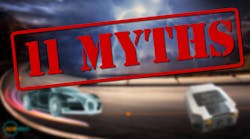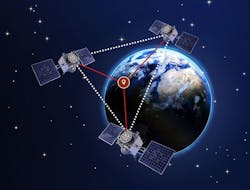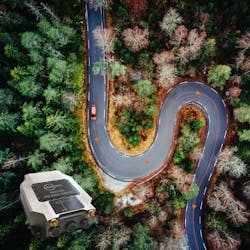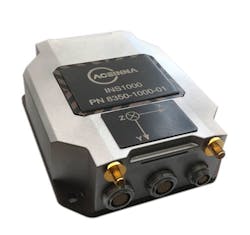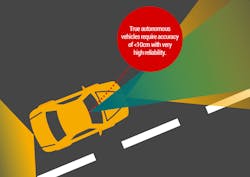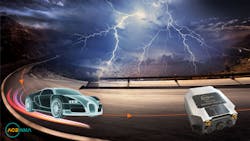Everyone knows that GPS uses satellites to deliver position information to things like smart watches and your car’s navigation system. But not so many know the details about just how sophisticated, complex, and advanced today’s satellite-based navigation systems truly are.
The Global Positioning System (GPS) was launched by the U.S. government in 1973 to offer satellite-based navigation anywhere on earth. There are about 30 satellites in the GPS constellation that continuously transmit the current time and their position down to earth. A GPS receiver on earth will observe multiple satellite signals. The receiver calculates the time it takes for the signal to arrive from the satellite. The receiver is able to triangulate its position by calculating the distance from each satellite being observed.
Despite its history, myths and misunderstandings surround GPS technology. This article debunks 11 of them.
1. GPS is the only satellite-based navigation system.
In the U.S., we tend to think about GPS as the primary satellite-based navigation system. It turns out others in the geospatial community have similar systems. Global Navigation Satellite System (GNSS) is the big picture—it’s an international term used to describe the complete collection of satellite constellations worldwide. The EU constellation of geo-positioning satellites is called GALILEO (Fig 1). The other three major systems are BeiDou for China and GLONASS for Russia. Each constellation has between 24 and 35 satellites in orbit. They broadcast their positioning signals across the globe in several different frequency bands.
1. The Global Navigation Satellite System (GNSS) consists of several different constellations with dozens of satellites circling the planet. An autonomous vehicle needs to connect with at least three to successfully triangulate its postion.
2. Modern GNSS receivers are reliable and proven for automotive systems.
An industrial-grade, dual-frequency, multi-constellation, GNSS receiver with 150+ channels will provide meter-level accuracy most of the time. These systems will be able to provide position information to the vehicle under most open sky conditions (Fig. 2).
2. GNSS receivers can provide precise positioning for a wide range of autonomous applications, including automotive, robotic, construction, and agricultural machinery.
However, urban canyons, tree-lined streets, tunnels, and underpasses can all block GNSS satellite signals long enough to interrupt the positioning. During these GNSS outages, an inertial measurement unit (IMU) should be used to measure the vehicle’s motion and orientation to estimate its position.
3. All automotive sensors sense the outside world.
In contrast to camera, LiDAR, radar and ultrasound sensors, the IMU is a sensor that requires no information or signals from outside a vehicle. The IMU measures the forces of acceleration (gravity and motion) and the angular rates of the vehicle. When combined with a GNSS receiver, the IMU can provide a complete positioning solution to accurately determine a vehicle’s position and attitude. When the GNSS signal isn’t available, the IMU measures the vehicle’s motion and estimates its position until the GNSS receiver can again access the satellites and recalculate the position.
4. GNSS/GPS without corrections is accurate enough for autonomous vehicles.
The best dual-frequency GNSS receiver with over 150 channels can track every positioning satellite signal within the visible skyline (Fig. 3). This marvel of modern engineering can deliver precision within about a meter, but it’s limited due to the inherent errors in sensing signals from space. Signals transmitted from space are affected by imprecision in the satellite orbit, satellite clock errors, and atmospheric disturbances.
3. Shown is ACEINNA’s INS1000 high-performance dual-band RTK INS (Real-Time Kinematic Inertial Navigation System) with built-in inertial sensors.
A real-time kinematic (RTK) positioning technique will use signals from a nearby fixed base station to measure these errors and transmit them to the vehicle. The use of an RTK correction network can allow for accuracies of 1 or 2 centimeters!
5. A MEMS gyro/accel chip works just fine for dead reckoning.
Many cars on the road today have simple navigation systems that provide basic positioning service. Unfortunately, the precision and reliability of these systems aren’t adequate for partially automated or highly automated autonomous vehicles (defined by the Society of Automotive Engineers as Levels 3, 4, and 5).
These basic navigation systems use less-accurate, single-frequency GNSS receivers to provide a satellite-positioning solution. Many also include a standalone MEMS gyro/accelerometer for “dead reckoning” when the GNSS signal isn’t available, such as in a tunnel or underpass. The low-quality GNSS receiver and drift-prone MEMS gyro/accel chips will only provide positioning accuracy within a few meters. In contrast, true autonomous vehicles require accuracy of <10 cm with very high reliability.
6. GNSS/GPS can work indoors and in a parking garage.
GPS or GNSS positioning is a satellite-based navigation system and requires that the antenna have clear line of sight to the satellites. Inside, the signals are attenuated and scattered by the roof and walls of buildings, making the information unreliable, inaccurate, and largely unavailable.
7. An IMU can estimate position during GNSS outages for several minutes.
While today’s precision IMUs are very accurate and reliable, the nature of the IMU dictates that the errors will accumulate with time. An IMU measures the acceleration of a body and integrates once to get velocity, and then integrates a second time to estimate position. The integration of the error associated with the sensors creates drift over time. Even a very precise IMU will still generate several meters of error in 60 seconds.
8. Multi-paths are great! The more signals the better.
An urban canyon is the canyon-like environment created by a dense cluster of tall buildings within the downtown of big cities (Fig. 4). Urban canyon effects can generate unusual wind and light patterns among others. To the satellite navigation community, urban canyons present a particular challenge of blocking the GNSS signals from directly reaching receivers, as well as creating reflections that can create multiple paths to the same receiver.
4. Because of challenges from reflected GNSS signals, or no signals at all, urban canyons can be very difficult for autonomous cars to navigate, especially when making left turns across lanes of traffic.
While you might think receiving multiple versions of the same signal would improve reception, this multipath reception in fact creates problems. The time-delayed signals can cause errors in identifying the correct (direct) signal with the correct timing information.
9. Autonomous cars only need LiDAR, camera, and radar sensors.
The debate about the need for LiDAR has received a lot of press in the last few years. What hasn’t received nearly as much coverage is the need for precise positioning information in an autonomous vehicle.
5. To safely navigate city streets, a true autonomous vehicle needs centimeter level of accuracy.
All of the information gathered by cameras, radar and, yes, LiDAR are used to identify markers and objects around the vehicle. To put all of this information in context, and to help provide a ground reference point, requires centimeter-level accurate positioning solution (Fig. 5). To deliver reliable, cost-effective, and centimeter-level accurate positioning information isn’t a trivial problem (Fig. 6). New GNSS/INS (Inertial Navigation Systems) must be developed for autonomous-vehicle applications to meet the growing needs of the automotive market.
6. New GNSS/INS (Inertial Navigation Systems) can deliver reliable, cost-effective, and centimeter-level accurate positioning information for autonomous cars.
10. Darkness, snow, rain and fog affect all automotive sensors.
Cameras can be impacted by darkness or extremely bright direct sunlight. LiDAR and radar can be impacted by rain, snow, or fog. However, the GNSS/INS system in the car is largely immune to these effects. GNSS was designed for positioning accuracy in all forms of environmental conditions and will operate in essentially all weather conditions. IMUs, which are also protected inside the body of a vehicle, receive no external signals and are completely immune to weather.
11. Precise GPS/GNSS isn’t needed until fully autonomous Level 5 vehicles.
Developers of advanced driving-assistance systems (ADAS) are quickly realizing that even Level 3 systems, which allow basic self-driving features in certain conditions (e.g. highways), require centimeter-level GNSS precision. The external sensors (camera, LiDAR, radar) are critical, but none of them can help in certain conditions like left-hand turns in intersections. During a left-hand turn, the view to the intended lane can be blocked by cars and other objects. None of these sensors can see around a large truck. The vehicle must have precise position information to know where it is and what path to follow through the intersection until it has a clear line of sight to the road it’s turning onto. A precise GNSS positioning solution is a requirement!
The Inertial Navigation industry is responding to the challenges presented by demanding new applications like autonomous vehicles, robotics, and drones to deliver precise positioning solutions that are accurate, cost-effective, and work under adverse conditions. GNSS and inertial navigation are seeing rapid advances in the hardware, software, and correction services to deliver the performance needed to spur the next wave of autonomy.
Dan Dempsey is the Senior Director of Automotive Business Development for ACEINNA.










